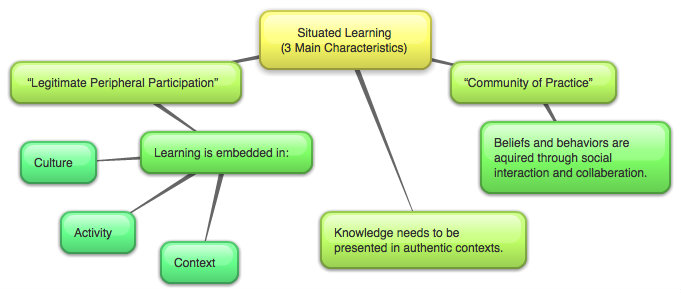Situated Learning Theory
Contributors:
William Rankin
Jean Lave 
Etienne Wenger
Situated learning is a theory on how individuals acquire professional skills, extending research on apprenticeship into how legitimate peripheral participation leads to membership in a community of practice. Situated learning "takes as its focus on the relationship between learning and the social situation in which it occurs
Put in terms developed by William Rankin, the major elements in situated learning are content (facts and processes of a task), context (situations, values, environmental cues), and community (the group where the learner will create and negotiate). Situated learning also involves participation (where a learner works together with others in order to solve a problem).
Situated learning deals with how one's knowledge over the course of an activity and how they create and interpret.
Content: In situated learning, no importance is given to the retention of the content. Rather, situated learning stresses reflective and higher-order thinking where the results are used in solving problems faced in daily life. Situated learning is thus more application-based.
Context: Context provides a framework for the usage of the product or the result at the right time, place and situation in the social, psychological and material environment. Context creates a platform to examine the learning experiences.
Community: Community helps the learner to create, interpret, reflect and form meanings. It provides opportunities to share experiences among learners and also to interact.
Participation: It is where the interchange of ideas, problem-solving and engaging of the learners take place. This takes place in a social setting which includes reflecting, interpreting and negotiating among the participants of the community.
Field trips where students actively participate in an unfamiliar environment
Cooperative education and internship experiences in which students are
immersed and physically active in an actual work environment
Music and sports (physical education) practice which replicate actual setting
of these events, e.g., orchestras, studios, training facilities
Laboratories and child-care centers used as classrooms in which students are
involved in activities which replicate actual work settings
These examples illustrate that students are actively involved in addressing real-world problems. As the practice implies, the student is “situated” in the learning experience and knowledge acquisition becomes a part of the learning activity, its context, and the “culture in which it is developed and used. Students form or “construct” their own knowledge from experiences they bring to the learning situation; the success of situated learning experiences relies on social interaction and kinesthetic activity.

https://www.youtube.com/watch?v=9rCwwUT9t04